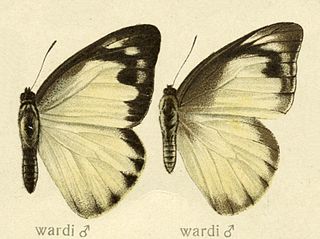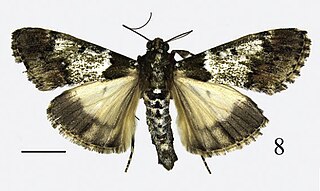
Appias wardii, the Indian albatross or Ward's albatross, is a small butterfly of the family Pieridae, that is, the yellows and whites, which is found in India.

Hexadactilia trilobata is a moth of the family Pterophoridae described by Thomas Bainbrigge Fletcher in 1910. It is found in Australia in Queensland and New Guinea.
Paraplatyptilia carolina is a moth of the family Pterophoridae described by William D. Kearfott in 1907. It is found in the southeastern United States, including Florida, southern Mississippi, North Carolina and Georgia.

Somena scintillans, the yellow tail tussock moth, is a moth in the family Erebidae described by Francis Walker in 1856. It is found in northern India, Sri Lanka, Myanmar and the Andaman Islands. Though considered a minor pest, larva can sporadically be a serious pest.
Tonica citrantha is a moth in the family Depressariidae. It was described by Alexey Diakonoff in 1967. It is found on Luzon in the Philippines.
Aroga elaboratella is a moth of the family Gelechiidae. It is found in North America, where it has been recorded from California and Baja California.
Arogalea albilingua is a moth of the family Gelechiidae. It is found in Mexico (Guerrero).
Arogalea senecta is a moth of the family Gelechiidae. It is found in Mexico (Guerrero).
Arogalea melitoptila is a moth of the family Gelechiidae. It is found in Brazil.
Coleotechnites stanfordia, the cypress leaf miner, is a moth of the family Gelechiidae. It is found in the United States, where it has been recorded from California.
Telphusa delatrix is a moth of the family Gelechiidae. It is found in Peru.
Physoptila scenica is a moth of the family Gelechiidae. It was described by Edward Meyrick in 1914. It is found in southern India.
Aristotelia ptilastis is a moth of the family Gelechiidae. It was described by Edward Meyrick in 1909. It is found in South Africa, where it has been recorded from the Western Cape.

Hieromantis arcuata is a moth of the Stathmopodidae family. It is found in China.

Teliphasa spinosa is a species of moth of the family Pyralidae. It is found in China (Yunnan).

Teliphasa similalbifusa is a species of moth of the family Pyralidae. It is found in China (Guangxi).

Teliphasa hamata is a species of moth of the family Pyralidae. It is found in China.
Aeolanthes lychnidias is a moth in the family Depressariidae. It was described by Edward Meyrick in 1908. It is found in southern India.
Rectiostoma eusema is a moth in the family Depressariidae. It was described by Lord Walsingham in 1914. It is found in Guatemala.

Trachypepla lichenodes is a moth of the family Oecophoridae first described by Edward Meyrick in 1883. It is endemic to New Zealand and has been found in both the North and South Islands. It inhabits native forest and adults of this species are on the wing from November to January. The adult moths are similarly coloured to native lichen species however this colouration is variable in the extent and depth on the forewings.







